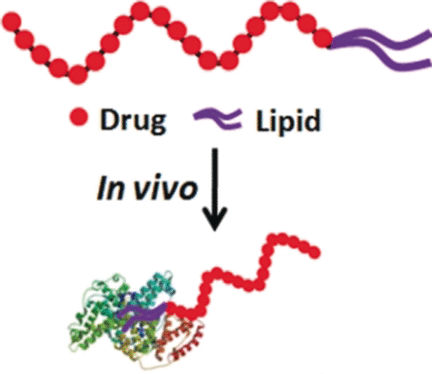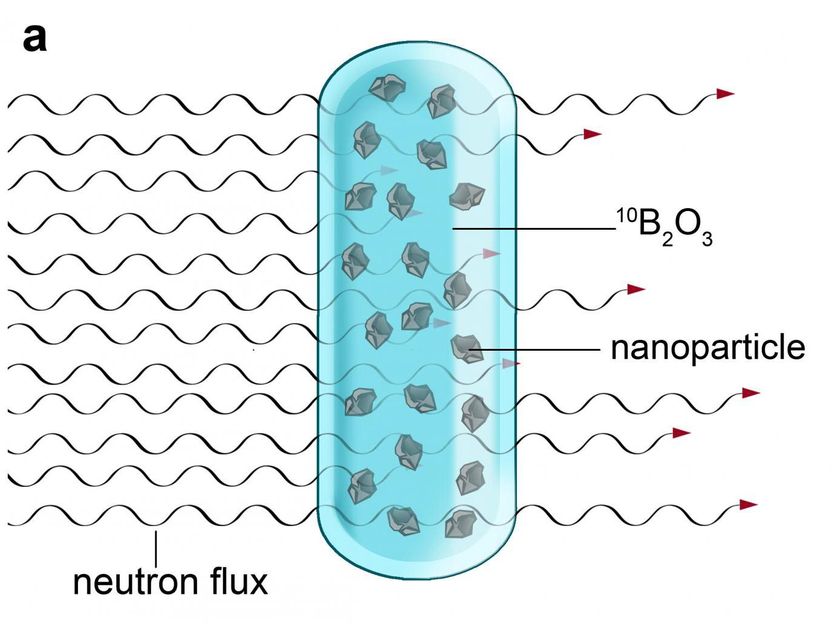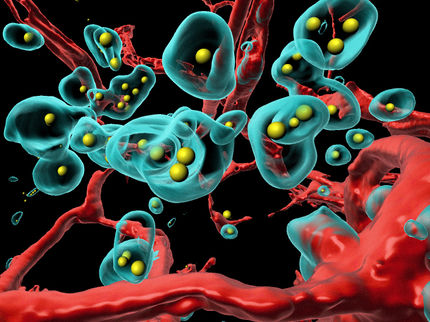Hitchhiking to Kill
Transport of lipid-conjugated floxuridine by natural serum albumin for delivery to cancer cells
How can elimination of therapeutics from the bloodstream or their early enzymatic degradation be avoided in systemic delivery? Chinese scientists have new developed a method to bind an established cancer therapeutic, floxuridine, with natural serum albumin for its transport and delivery to target cancer cells. In the journal Angewandte Chemie, the authors demonstrate the Automated synthesis of a conjugated floxuridine polymer, its successful transport and delivery, and its efficiency in stopping tumor growth.

© Wiley-VCH
How can we get a drug to its target? Despite much progress in nanocarrier research, the problem is still persistent, especially in cancer therapy. During transport in the bloodstream, the anticancer drugs may interfere with healthy cells, or they may be degraded by enzymes or eliminated from the body before entering the tumor tissue. Envisaging a natural and safe carrier system, Weihong Tan and colleagues at Hunan University, China, and the University of Florida, USA, chose endogeneous serum albumin as a possible nanotransporter. To ensure binding of the antimetabolite floxuridine to albumin, they had to modify it.
Floxuridine is a fluorinated pyrimidine nucleoside and antimetabolite, which inhibits the enzymes of DNA synthesis. Its oligomer, an oligonucleotide of 10 units, is even more efficient and is actively internalized in the cell. To make it transportable by serum albumin, Prof. Tan and his group decided to endow the oligonucleotide with hydrophobic alkyl chains as a linker. This was necessary because albumin naturally transports lipophilic molecules such as lipids and cholesterol, but not negatively charged oligonucleotides.
The synthesis of the alkyl-chain-conjugated floxuridine oligonucleotide containing 20 units (LFU20) proceeded on a DNA synthesizer. The authors tested the compound for its interaction with serum albumin, cell internalization, transport through the bloodstream in tumor-implanted mice, and tumor proliferation. They observed that although a large fraction of the drug still left the body, a much higher proportion than in the control group accumulated in the tumor. There, the drug was internalized in the cells. The “enhanced permeability and retention effect” directed the accumulation, an effect well established in tumor research. In the cells, the lysosomes take up the drug, and enzymes release the antimetabolic floxuridine structure, the authors note.
The scientists reported that tumor proliferation was halted by the lipid-conjugated compound, whereas the free FU20 drug without lipid anchor could not stop tumor growth. This means that LFU20 appears to “hitchhike” with albumin to find the target cells and accumulate therein. The authors also pointed out that the drug is easily prepared by automated synthesis, and the hydrophobic lipid tail, which ensures the albumin affinity, can be readily incorporated at the 5’-terminus of the oligonucleotide. Hitchhiking with killing potential pays off in drug delivery.
Original publication
Other news from the department science

Get the life science industry in your inbox
By submitting this form you agree that LUMITOS AG will send you the newsletter(s) selected above by email. Your data will not be passed on to third parties. Your data will be stored and processed in accordance with our data protection regulations. LUMITOS may contact you by email for the purpose of advertising or market and opinion surveys. You can revoke your consent at any time without giving reasons to LUMITOS AG, Ernst-Augustin-Str. 2, 12489 Berlin, Germany or by e-mail at revoke@lumitos.com with effect for the future. In addition, each email contains a link to unsubscribe from the corresponding newsletter.
Most read news
More news from our other portals
Last viewed contents
Methylmalonyl-CoA_mutase_deficiency
Phleboviruses
Müllerian_duct
California_Constitution_Article_XXXV

Artificial intelligence improves lung cancer diagnosis - New AI-based digital platform enables extremely fast and accurate analysis of tissue sections from lung cancer patients
Physical_therapy
Rhodocybe






















































